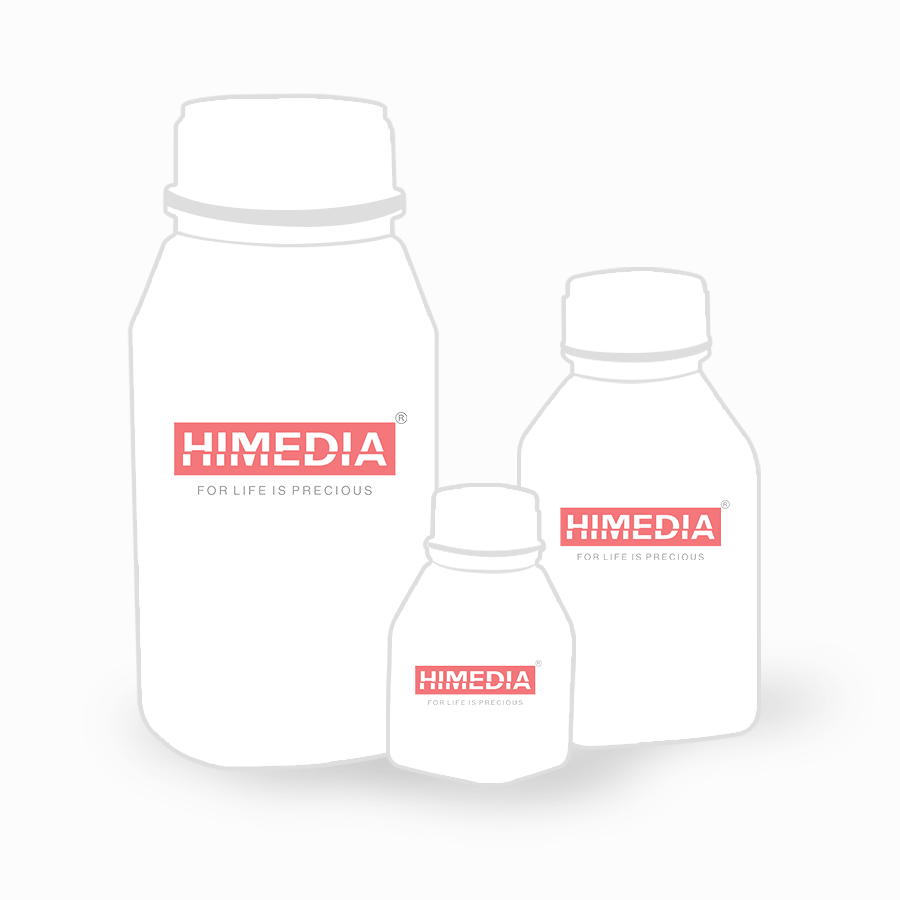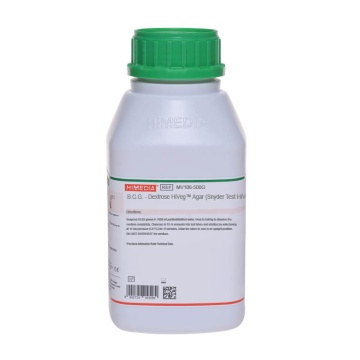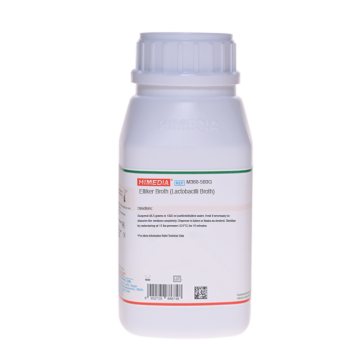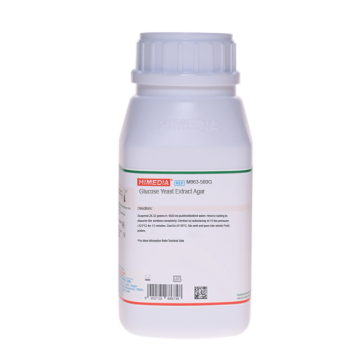 Your enquiry has been submitted
Your enquiry has been submitted
B.C.G. - Dextrose Agar (Snyder Test Agar)
Intended Use
Recommended for the estimation of Lactobacilli, an indication of caries activity.
Composition**
| Ingredients | g/L |
|---|---|
| Peptone | 20.000 |
| Dextrose (Glucose) | 20.000 |
| Sodium chloride | 5.000 |
| Bromocresol green | 0.020 |
| Agar | 20.000 |
Final pH (at 25°C): 4.8±0.2
**Formula adjusted, standardized to suit performance parameters
Directions
Suspend 65.02 grams in 1000 ml purified/distilled water. Heat to boiling to dissolve the medium completely. Dispense in 10 ml amounts into test tubes and sterilize by autoclaving at 15 lbs pressure (121°C) for 15 minutes. Allow the tubes to cool in an upright position. DO NOT OVERHEAT the medium.
Principle And Interpretation
Dental caries results from microbial acid and plaque formation. Plaque sets the stage for caries because it collects the acid forming bacteria on the tooth surface, supplies an anaerobic environment for fermentation, traps the acids and excludes the protective saliva. Caries lesions are basically the outcome of chemical attack on the enamel and dentin. Demineralization of the tooth alternates with periods of re-mineralization. If demineralization exceeds re-mineralization, a subsurface carious lesion becomes a clinical cavity with extension of the decay into the dentine (1). For determining the rate and amount of acid produced by microorganisms in saliva, Snyder (2,3) described a colorimetric method. The procedure makes use of an agar medium that is known as Snyder Test Agar. Later on Alban (4) modified the procedure and reported it to be more accurate than the original procedure.
This is a differential medium based on the rate of acid production from dextrose, by oral acidogenic microorganisms from buccal cavity and is evidenced by a change in colour of the indicator - bromo cresol green from blue-green to yellow (5). Peptone provides carbon, nitrogen, long chain amino acids, vitamins and minerals. Dextrose is the carbohydrate source and bromo cresol green is the pH indicator.
Snyder Test Procedure:
Collect specimens of saliva before breakfast, before brushing the teeth or just before lunch or dinner. Collect specimen of saliva in a sterile tube or bottle after patient chews paraffin for 3 minutes. Shake the specimen thoroughly and transfer 0.2 ml of this to a sterile Snyder Test Agar tube melted and cooled to 45°C. Mix the inoculum by rotating the inoculated tubes and incubate at 37°C for 72 hours in an upright position. The rate of acid production is graded as, marked for 24 hours, moderate and slight if colour changes within 48 and 72 hours respectively (6).
| Incubation hours | Colour | Caries activity |
|---|---|---|
| 24 | yellow | marked |
| 48 | greenish yellow | moderate |
| 72 | yellowish green | slight |
Alban Modified Test Procedure:
Collect the saliva specimen (unstimulated) to just cover the medium in the tube. When specimen collection is difficult, dip a sterile cotton swab into the saliva under the tongue or rub on tooth surfaces and place the swab just below the surface of the medium. Incubate the tubes at 35°C along with uninoculated control. Examine tubes daily for 4 days and compare the colour change with the control tube.
Result Interpretation
Record the results as:
- No colour change as negative : -
- Colour beginning to change to yellow : +
- Half medium yellow : ++
- Three fourths of medium yellow : +++
- Total medium yellow : ++++
The daily readings indicate the rapidity and amount of acid production. To establish a reference point at least two specimens collected within 2-4 days must be obtained.
Type of specimen
Clinical samples - Saliva
Specimen Collection and Handling:
For clinical samples follow appropriate techniques for handling specimens as per established guidelines (6,7). After use, contaminated materials must be sterilized by autoclaving before discarding.
Warning and Precautions
In Vitro diagnostic Use only. For professional use only. Read the label before opening the container. Wear protective gloves/protective clothing/eye protection/ face protection. Follow good microbiological lab practices while handling specimens and culture. Standard precautions as per established guidelines should be followed while handling clinical specimens. Safety guidelines may be referred in individual safety data sheets.
Limitations :
- Some organisms may show poor growth due to variable nutritional requirements.
Performance and Evaluation
Performance of the medium is expected when used as per the direction on the label within the expiry period when stored at recommended temperature.
Quality Control
Appearance Light yellow to greenish yellow homogeneous free flowing powder
Gelling Firm, comparable with 2.0% Agar gel.
Colour and Clarity of prepared medium Emerald green coloured, clear to slightly opalescent gel forms in tubes
Reaction Reaction of 6.5% w/v aqueous solution at 25°C. pH: 4.8±0.2
Cultural Response Cultural characteristics observed after an incubation at 35-37°C for 24-72 hours.
| Organism | Inoculum (CFU) | Growth | Acid production |
|---|---|---|---|
| Lactobacillus acidophilus ATCC 314 | 50-100 | good-luxuriant | positive reaction, yellow colour |
| Lactobacillus casei ATCC 9595 | 50-100 | good-luxuriant | positive reaction, yellow colour |
| Lactobacillus fermentum ATCC 9338 | 50-100 | good-luxuriant | positive reaction, yellow colour |
| Staphylococcus aureus subsp. aureus ATCC 25923 (00034*) | 50-100 | none-poor | negative reaction, no colour change |
Key: *Corresponding WDCM numbers.
Storage and Shelf Life
Store between 10-30°C in a tightly closed container and the prepared medium at 2-8°C. Use before expiry date on the label. On opening, product should be properly stored dry, after tightly capping the bottle in order to prevent lump formation due to the hygroscopic nature of the product. Improper storage of the product may lead to lump formation. Store in dry ventilated area protected from extremes of temperature and sources of ignition Seal the container tightly after use. Product performance is best if used within stated expiry period.
Disposal
User must ensure safe disposal by autoclaving and/or incineration of used or unusable preparations of this product. Follow established laboratory procedures in disposing of infectious materials and material that comes into contact with clinical sample must be decontaminated and disposed of in accordance with current laboratory techniques (6,7).
Reference
- Lewis and Ismail, 1995, Can. Med. Assoc. J., 152:836.
- Snyder, 1941, J. Dent. Res., 20:189.
- Snyder, 1941, J. Am. Dent. Assoc., 28:44.
- Alban, 1970, J. Dent. Res., 49:641.
- MacFaddin J. F., 1985, Media for Isolation-Cultivation-Identification-Maintenance of Medical Bacteria, Vol. I, Williams & Wilkins, Baltimore, Md.
- Isenberg, H.D. Clinical Microbiology Procedures Handbook 2nd Edition.
- Jorgensen, J.H., Pfaller, M.A., Carroll, K.C., Funke, G., Landry, M.L., Richter, S.S and Warnock., D.W.(2015) Manual of Clinical Microbiology, 11th Edition. Vol. 1.
| Product Name | B.C.G. - Dextrose Agar (Snyder Test Agar) |
|---|---|
| SKU | M106 |
| Product Type | Regular |
| Physical Form | Powder |
| Origin | Animal |
| Packaging type | HDPE |
| References | 1. Lewis and Ismail, 1995, Can. Med. Assoc. J., 152:836. 2.Snyder, 1941, J. Dent. Res., 20:189. 3.Snyder, 1941, J. Am. Dent. Assoc., 28:44. 4.Alban, 1970, J. Dent. Res., 49:641. 5.MacFaddin J. F., 1985, Media for Isolation-Cultivation-Identification-Maintenance of Medical Bacteria, Vol. I, Williams& Wilkins, Baltimore, Md. 6..Isenberg, H.D. Clinical Microbiology Procedures Handbook. 2nd Edition. 7.Jorgensen,J.H., Pfaller , M.A., Carroll, K.C., Funke, G., Landry, M.L., Richter, S.S and Warnock., D.W. (2015)Manual of Clinical Microbiology, 11th Edition. Vol. 1. |
| Customized Product Available | No |









